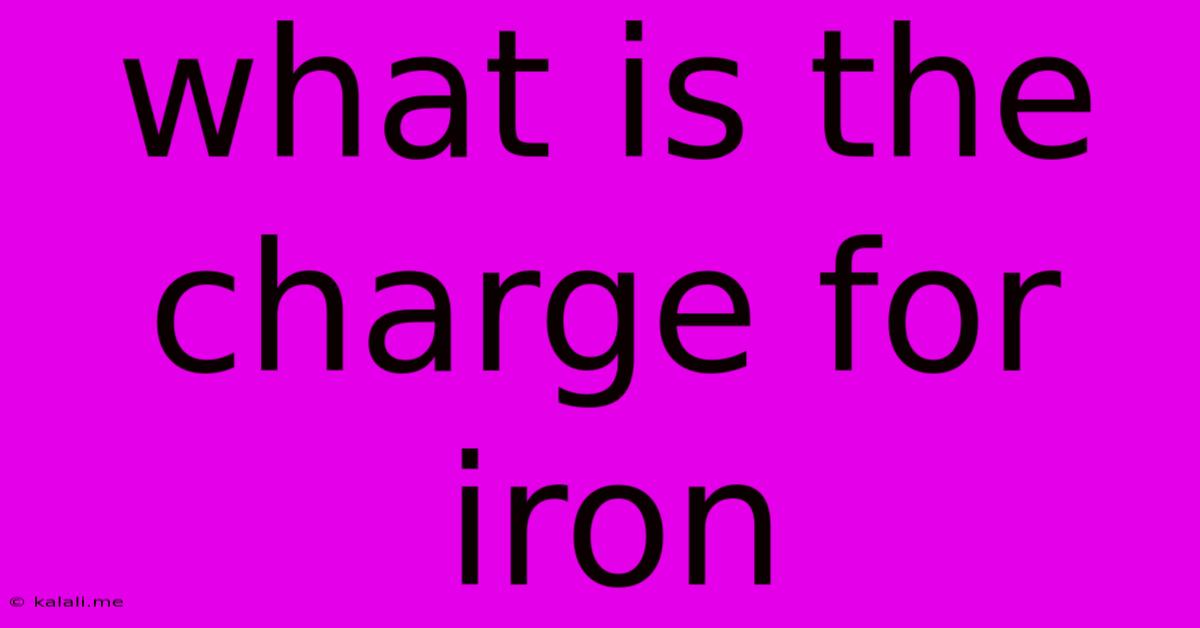What Is The Charge For Iron
Kalali
Jun 03, 2025 · 3 min read

Table of Contents
What is the Charge of Iron? Understanding Oxidation States
Iron, a ubiquitous element crucial for life and industry, doesn't possess a single, fixed charge. Instead, its charge, more accurately termed its oxidation state, varies depending on its chemical environment and bonding partners. This article will explore the common oxidation states of iron and the factors influencing them. Understanding this is key to comprehending its diverse chemical behavior and its role in various applications.
Iron's versatility stems from its electronic configuration. With an atomic number of 26, its electronic configuration is [Ar] 3d⁶ 4s². This means it has several electrons that can be readily involved in chemical bonding, leading to multiple possible oxidation states.
Common Oxidation States of Iron
The two most common oxidation states of iron are:
-
+2 (Ferrous): In this state, iron has lost two electrons, resulting in a 2+ charge. Compounds containing iron(II) are often referred to as ferrous compounds. Examples include ferrous sulfate (FeSO₄), a common dietary supplement, and ferrous oxide (FeO), a component of some pigments.
-
+3 (Ferric): Here, iron has lost three electrons, giving it a 3+ charge. Compounds with iron(III) are called ferric compounds. Hematite (Fe₂O₃), a major iron ore, is a prime example, as is ferric chloride (FeCl₃), used in water treatment.
Less Common Oxidation States
While +2 and +3 are dominant, iron can exhibit other, less common oxidation states, including:
-
0: Elemental iron, as found in its metallic form, has an oxidation state of zero.
-
+4: This state is relatively rare and usually found in specific compounds under controlled conditions.
-
+6: Even rarer than +4, this oxidation state is mostly observed in ferrates, which are powerful oxidizing agents.
Factors Affecting Iron's Oxidation State
Several factors dictate which oxidation state iron will adopt in a given compound:
-
The nature of the ligands: Ligands are the atoms or molecules directly bonded to the iron atom. Different ligands can stabilize different oxidation states. For example, strong field ligands tend to favor the +3 state, while weak field ligands may favor the +2 state.
-
The pH of the solution: The acidity or basicity of the solution can significantly influence the stability of different oxidation states. For instance, in acidic solutions, the +3 state is more stable, while in alkaline solutions, the +2 state might be favored.
-
The presence of oxidizing or reducing agents: Oxidizing agents can promote the formation of higher oxidation states (like +3), whereas reducing agents favor lower oxidation states (like +2).
-
Temperature and pressure: These parameters can also play a subtle role in influencing the stability of different oxidation states.
Conclusion
The charge of iron is not a fixed value but rather a variable oxidation state, primarily existing as +2 (ferrous) and +3 (ferric). Understanding the factors influencing this variability is crucial for comprehending iron's behavior in various chemical and biological processes. Further exploration into coordination chemistry and redox reactions will provide a deeper understanding of this complex element's fascinating properties.
Latest Posts
Latest Posts
-
If It Is Not Raining Should I Cut My Grass
Jun 05, 2025
-
What Happens When A Landlord Refuses To Give Owners Name
Jun 05, 2025
-
What Main Stats Can Sands Be
Jun 05, 2025
-
Why Does My Coffee Taste Watery
Jun 05, 2025
-
Is It Legal To Ask Why Someone Left A Job
Jun 05, 2025
Related Post
Thank you for visiting our website which covers about What Is The Charge For Iron . We hope the information provided has been useful to you. Feel free to contact us if you have any questions or need further assistance. See you next time and don't miss to bookmark.